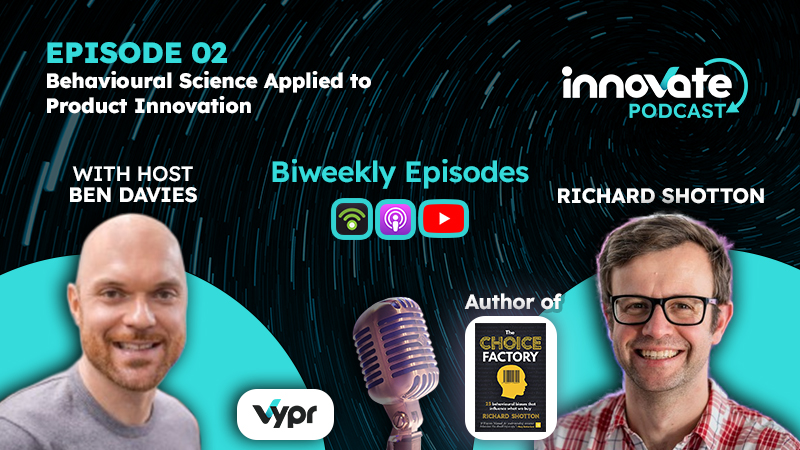Applying science to innovation – Innovate podcast with Richard Shotton

Applying Science to Innovation – Innovate Podcast with Richard Shotton
The Innovate Podcast is a biweekly series of discussions with CPG Innovation experts, on how to innovate with success in an ever-changing world.
In the second episode, our host Vypr Founder Ben Davies was joined by Author of Bestseller ‘The Choice Factory’, Richard Shotton.
Ben and Richard discussed the application of Behavioural Science to Innovation, from common biases that influence purchasing decisions, to applications in industry challenges like the cost-of-living crisis.
Listen to the full episode using the links below, and don’t forget to subscribe so you never miss an episode.
Listen on Podbean, Listen on iTunes or Watch on YouTube
Read the highlights below.
What is Behavioural Science?
Richard described the discipline as “the study of how people actually behave rather than how they claim to behave”.
This means Behavioural Science is incredibly relevant to product innovation, as he emphasised.
“If you think about what Behavioural Science is, it is thousands upon thousands of researchers running studies looking into what actually changes behaviour. I would struggle to think of a more relevant topic”
Richard explored its applications to Innovation, by discussing some important principles, as follows:
1. Context Matters
Behaviour is different in different contexts.
Applying this principle to supermarket shopping behaviour, we see that when consumers shop for a product, they’re often setting comparisons to items in the overall aisle.
For example, certain companies have set their prices by strategically designing products to compare to more up-market ranges. A certain non-alcoholic drink brand charges around £25 for its product, by making its comparison set craft gins, so when people compare it to the price of craft gins surrounding it in the aisle, usually about £30, they will be willing to buy at £25 as comparatively it’s a decent price.
If they were to place the same product in a different aisle with a cheaper comparison set by having a less up-market design and packaging like a plastic bottle, people would never be willing to spend more than around £5.
“Shift your comparison set and you can shift people’s willingness to pay by absolute orders of magnitude”
The applications
It’s essential to reframe how your new product is designed and introduced to people, to harness the above principle, called price relativity.
“By changing the reference set, the benchmark people are prepared to pay changes”
2. Social Proof
We copy what others do.
As a species, we tend to watch and follow what other people do, which can be applied to product purchasing behaviour.
“A subtle cue about the popularity of a behaviour can change how likely people are to do it”
A literal application of this principle in product marketing, would be phrases used by brands like ‘We’re Britain’s most popular…’ or ‘9 out of 10 customers recommend us’, but the principle can be applied to product innovation too.
For example, it’s mostly about making products become as visible as possible, so people think they’re more popular than they are, such as by having a striking and unique design. As long as a product is good quality, perceptions of popularity often matter more than the actual number of people buying them. Find out how a certain brand has embraced this principle in the full podcast.
The applications
Make your product more visible by realising that human nature is often focused on what’s popular. Along with having a great product, make designs stand out and usage visible, to create a desire to use the product, and increase growth.
“Social proof is an absolute must for any product innovator – how can you make your product appear more popular”
3. The Intention-to-Action Gap
Products associated with moments tend to grow faster.
Creating a desire and motivating people to act is not always going to translate into actual behaviour. Often it’s essential to combine this motivation with a trigger moment. This means associating a specific time or mood to act as a trigger, which converts the desire fueled by motivation, to an actual behaviour.
This can be applied to product use. For example, champagne is mostly associated with a moment – celebration. So, combining product desirability with a time, place, or mood, can really increase growth.
The applications
Don’t just rely on creating a desire to use the product, but also associating a particular time, place or mood, with it. But it’s essential to be careful not to overuse this principle, and associate with absolutely everything that could be relevant.
“Better to successfully associate yourself with a particular moment rather than try and do everything.”
In the full episode, Richard discussed more on harnessing the power of Behavioural Science, covering topics such as:
- Adapting to industry challenges like the cost-of-living crisis
- Experimental findings applied to innovation
- Examples of how brands have maintained success using these principles
If you want to catch all these insights, listen to the full podcast on-demand. Click the links below to listen on your preferred platform.







